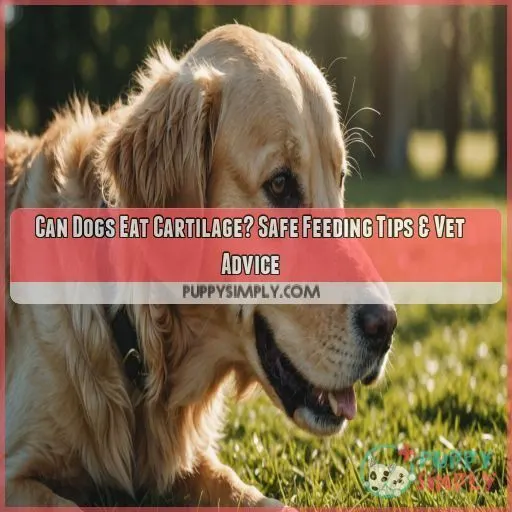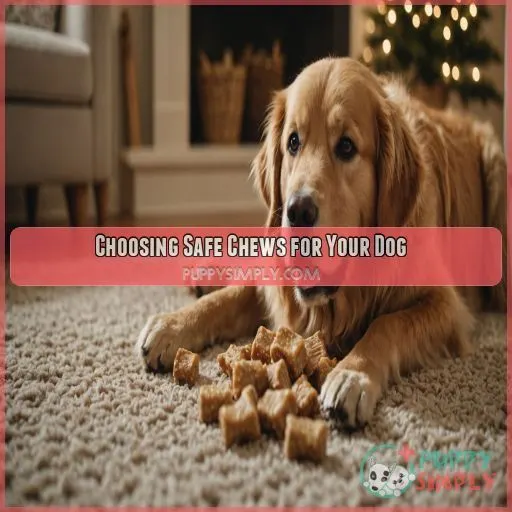This site is supported by our readers. We may earn a commission, at no cost to you, if you purchase through links.

Think of cartilage as a tiny, tasty superhero helping fend off arthritis with glucosamine and chondroitin as its sidekicks.
Always choose vet-approved products to keep your four-legged friend wagging happily.
Curious about the safest ways to feed cartilage and pick the best chew toys? You’ve landed in the right spot—let’s dig deeper!
Table Of Contents
- Key Takeaways
- What is Cartilage for Dogs?
- Can Dogs Eat Raw Bones?
- Cooked Bones and Cartilage for Dogs
- Choosing Safe Chews for Your Dog
- Veterinary Advice on Cartilage and Bones
- Frequently Asked Questions (FAQs)
- Can dogs eat connective tissue?
- What does cartilage do for dogs?
- Is fish cartilage good for dogs?
- Is turkey cartilage good for dogs?
- How much cartilage is safe for dogs?
- Are there age restrictions for cartilage consumption?
- Can cartilage help with dental hygiene in dogs?
- What are signs of cartilage-related digestive issues?
- Are certain types of cartilage more beneficial for dogs?
- Conclusion
Key Takeaways
- Cooked cartilage is a safe, nutritious option for dogs, packed with protein and joint-supporting nutrients like glucosamine and chondroitin. But steer clear of raw cartilage—it can upset your pup’s tummy.
- When feeding cartilage, always choose vet-approved products and supervise your dog to ensure they don’t choke or experience digestive issues. Moderation is key!
- Cartilage from beef, fish, and turkey sources each offers unique benefits, so mix it up to keep your canine companion happy and healthy.
- Consult your vet before introducing cartilage or any new treats to your dog’s diet. They can recommend safe, vet-approved options and ensure it aligns with your pup’s individual needs.
What is Cartilage for Dogs?
Cartilage can be a beneficial addition to your dog’s diet, offering nutrients like protein and glucosamine that support joint health. But before you let your pup indulge, remember the potential risks of raw cartilage, which can sometimes lead to tummy troubles, and how to serve it safely.
Benefits of Cartilage for Dogs
When considering cartilage for your dog, think of it as a protein-packed treat that offers:
- Nutritional benefits: Rich in protein and calcium.
- Joint health: Glucosamine and chondroitin aid arthritis relief.
- Digestive aid: Easy on their tummy.
- Dog health: Safe chews improve well-being.
Risks of Raw Cartilage for Dogs
While cartilage can offer health benefits, raw cartilage presents risks like digestive upset and bacterial contamination. It’s a bit like playing fetch with a cactus—poke-prone! You must keep puppy safety in mind, as choking and intestinal blockages could occur.
How to Feed Cartilage to Dogs Safely
To feed cartilage safely, opt for vet-approved commercial products. Avoid raw cartilage, which can cause digestive issues. Instead, try dried, dehydrated, or cooked cartilage treats – just be sure to supervise your pup and discard any worn-down pieces.
Types of Cartilage for Dogs (Beef, Fish, Turkey)
When feeding cartilage to your dog, consider beef, fish, and turkey options. Each source has unique benefits, like chondroitin and glucosamine for joint health. Remember, raw cartilage can pose risks like digestive issues, so preparation is key for safe chewing.
Cartilage as a Treat or Supplement
Cartilage as a treat or supplement offers glucosamine benefits for arthritis relief and cartilage protein for digestive health. Vet recommendations suggest using natural ingredients. Unlike risky chicken and lamb bones, it’s easily incorporated into your dog’s safe, tasty, cooked bone regimen.
Can Dogs Eat Raw Bones?
So, your dog’s spotted a raw bone and you’re wondering if it’s safe to let them chomp away? While dogs have chewed on bones for ages, modern vets caution against it due to risks like broken teeth and choking hazards.
Risks of Raw Bones for Dogs (Broken Teeth, Choking)
Exploring raw bones for dogs can be a bone of contention. In plain terms, dental damage and choking hazards are serious stalking horses when offering raw bones to your furry buddy. Sharp fragments can wreak havoc with gastrointestinal injury or even spark a nasty peritonitis risk. So, chew on this:
- Broken Teeth: Expensive dental dramas.
- Choking Hazards: Swift removal encouraged.
- Indigestion Issues: Unhappy tummies abound.
Types of Raw Bones to Avoid (Chicken, Lamb)
Imagine this: your dog eyeing that chicken leg like it’s the Holy Grail. But beware! Chicken bone dangers and lamb bone hazards lurk. Soft bone risks include splinters causing injuries, while small bone issues can lead to choking. Instead of playing a risky game of fetch with raw bones, remember this table:
| Bone Type | Risk | Why Avoid? |
|---|---|---|
| Chicken | Splinters | Mouth injuries |
| Lamb | Choking | Blockages |
| Small | Obstructions | Digestion problems |
Stay safe and stick to safer options!
Safe Alternatives to Raw Bones
Now that you’re in the know about what bones to steer clear of, let’s sink our teeth into some safer options. Consider these alternatives:
- Natural Rubber Toys: These won’t break a tooth but provide hours of joy.
- Nylon Chew Toys: Durable, long-lasting, and safe for vigorous chewers.
- Soft Dental Chews: Great for oral hygiene—think of them as a toothbrush with benefits!
Your pup deserves safe fun!
Cooked Bones and Cartilage for Dogs
Regarding your dog’s diet, not all bones are safe to serve, especially cooked ones that could pose risks of splintering. But dont let that scare you awaycooked cartilage can be a tasty and beneficial treat if prepared properly, offering a chewy delight that keeps your pup wagging for more.
Can Dogs Eat Cooked Bones?
Cooked bones might seem appealing, but they can pose serious digestive risks. Cooking makes bones brittle, increasing the chance of splintering. It’s like baking a cookie too long – crumbles everywhere! For your dog’s safety, follow feeding guidelines and stick to vet recommendations. Opt for safer alternatives instead.
Benefits of Cooked Cartilage for Dogs
With cooked cartilage, you can offer your dog a protein-packed feast that rivals any tail-wagging special. Enhanced digestibility means calcium enrichment, supporting bone health and potentially easing arthritis woes. These beneficial nutrients improve overall nutrient absorption, like sending in a friendly squad of enzymes on a mission for health.
How to Prepare Cooked Cartilage for Dogs
To safely cook cartilage for dogs, start by boiling or steaming it to soften the texture. Remove any bones for added safety. Source high-quality cartilage, ensuring it’s fresh and clean. Store leftovers in the fridge. Remember, moderation is key—too much cartilage might send Fido on a gastrointestinal rollercoaster!
Cooked Bone Treats From the Shop: Safe or Not?
When shopping for bone treats, be wary – not all are created equal. Avoid cooked, brittle bones that can splinter and pose choking hazards. Instead, opt for vet-approved, natural chews made from ingredients like rawhide or dried sweet potato. Your pup’s safety should always come first when choosing the right chew.
Choosing Safe Chews for Your Dog
Choosing the right chews for your dog is like finding the perfect shoe; it needs to fit just right and endure all their adventures. By understanding your dog’s chewing style and avoiding artificial ingredients, you can keep your pet safe and satisfied.
Know Your Dog’s Chewing Style
You’ve just learned about safe treatments, so let’s chew on your dog’s style. Every pooch is unique! Some are gentle nibblers, while others tackle like footballers. Consider your dog’s chewing aggression and breed preferences. Always supervise, and remember to replace worn chews to guarantee safety and happiness.
Factors to Consider (Hardness, Longevity, Durability)
As you consider your dog’s chewing habits, focus on choosing chews that match their aggression leveldon’t let them bite off more than they can chew! Use a hardness scale for guidance. Prioritize durable materials that stand the test of time and make certain the chew lifespan satisfies your furry friend’s entertainment needs.
Ingredients to Avoid (Artificial Flavorings, Coatings)
Choosing chews? Don’t forget ingredients! Avoid these:
- Artificial preservatives – They’re like uninvited guests at a party.
- Harmful additives – These can upset your dog’s tummy.
- Unwanted chemicals – Nobody wants those hanging around.
- Synthetic colors – A vibrant no-no!
Choose wisely for your dog’s health.
Size Matters: Choosing the Right Chew Size
After dodging artificial extras, tackle chew sizes! Choosing the right size is no small potatoes. Small breeds appreciate petite options, while large breeds need hefty ones to avoid accidental consumption. Customizable chew sizes offer benefits galore, ensuring Fluffy’s gnashers stay intact. Remember, medium-sized chews can pose hazards too!
Veterinary Advice on Cartilage and Bones
Regarding dogs munching on cartilage and bones, veterinarians have some important advice to share, ensuring your furry friend’s chomping remains safe and sound. Consulting your vet about safe chew options helps keep tails wagging without hefty vet bills to spoil the fun!
When to Consult a Veterinarian
When choosing chews, know when to call the vet. If your dog shows unusual behavior, persistent symptoms, or digestive issues, seek expert opinions pronto. In emergency situations, it’s better safe than sorry—don’t brush it off!
Vet-Approved Products for Daily Chewing
Your vet can recommend safe, durable chews made from natural ingredients that won’t crack teeth or cause digestive issues. Look for products endorsed by veterinary experts for responsible daily chewing.
Supplements Like Glucosamine and Chondroitin
For your dog’s joint health, glucosamine and chondroitin are top dogs, offering arthritis relief and long-term benefits. Dosing’s a breeze with natural supplements, just consult your vet for paw-sitively effective recommendations. Your pup will thank you!
Prioritizing Safety When Choosing Chews and Treats
While choosing glucosamine supplements, it’s also key to prioritize safety with chews and treats. No need to roll the dice with your dog’s health. Consider these tips:
- Chew Material Safety: Check durability!
- Ingredient Transparency: Natural is best.
- Chew Shape Considerations: Avoid sharp edges.
- Supervision Necessity: Always watch!
- Chew Usage Frequency: Don’t overdo it.
How Dog Insurance Can Help
Safety is key when picking dog treats, but accidents happen. That’s where dog insurance swoops in! It helps manage hefty vet bills from unexpected illness. Consider coverage benefits for emergency care, giving you peace of mind.
Choosing the Right Dog Insurance for Your Pet
Dog insurance can jump through hoops for you. When choosing a provider, consider these tips:
- Dog insurance costs
- Coverage options
- Claims process
- Insurance benefits
Find peace of mind for your furry friend!
Frequently Asked Questions (FAQs)
Can dogs eat connective tissue?
Sure, dogs can eat connective tissue, like cartilage, but don’t go barking up the wrong tree! Connective tissue isn’t easily digestible and can cause tummy troubles. Scooby-Doo would probably say, "Consult your vet before serving up!
What does cartilage do for dogs?
Cartilage is like a superhero snack for dogs. It provides protein, calcium, glucosamine, and chondroitin, which are great for joint health, especially for dogs with arthritis. Just be cautious—consult your vet for safer supplement options.
Is fish cartilage good for dogs?
Did you know fish cartilage can be a great addition to your pup’s diet? It’s packed with beneficial nutrients like glucosamine and chondroitin that may support their joint health. Just be sure to introduce it slowly and consult your vet first.
Is turkey cartilage good for dogs?
Turkey cartilage can be safe and nutritious for dogs if it’s given in moderation. It’s packed with protein and glucosamine, great for joint health. Always consult your vet first to verify it’s the right treat for your pup!
How much cartilage is safe for dogs?
Imagine cartilage as the goldilocks of dog treats—just right when given in moderation. Don’t go overboard; a little bit can be beneficial. Always consult your vet to confirm it suits your dog’s health and size.
Are there age restrictions for cartilage consumption?
Regarding cartilage, steer clear for pups and young dogs. Their little tummies can’t handle it well. Think of their digestion like a training wheelit needs time to mature before handling such complex material!
Can cartilage help with dental hygiene in dogs?
Cartilage can act like a toothbrush for your dog, scraping away plaque and tartar as they munch. But remember, it’s not the magic bullet—always supervise and consult your vet for safer dental options.
What are signs of cartilage-related digestive issues?
Your dog might stir the pot with signs like vomiting, diarrhea, or loss of appetite after munching on cartilage. Watch their stool and energy levels. If you notice any quirks, it’s time to call the vet!
Are certain types of cartilage more beneficial for dogs?
Certain types of cartilage, like those found in approved dog chews, can be more beneficial. They’re like nature’s gummy bears, packed with glucosamine and chondroitin, but always consult your vet first for your dog’s unique safety.
Conclusion
Picture a disco ball hanging in your dog’s belly when you’re figuring out if dogs can eat cartilage—the right moves keep the party going smoothly.
Embrace cooked cartilage for its beneficial glucosamine and chondroitin, and always avoid raw cartilage disasters.
Prioritize vet-approved snacks and chew toys to keep Rover grooving safely.











